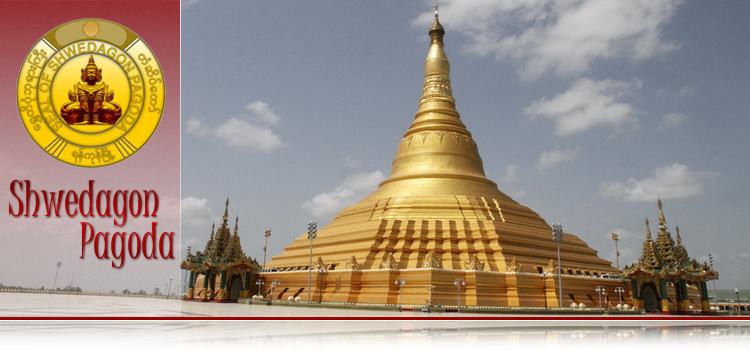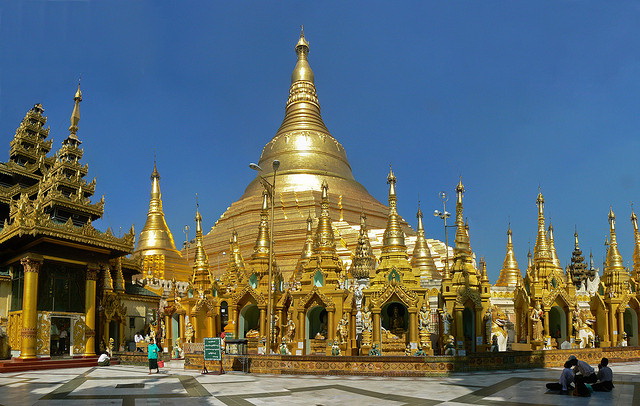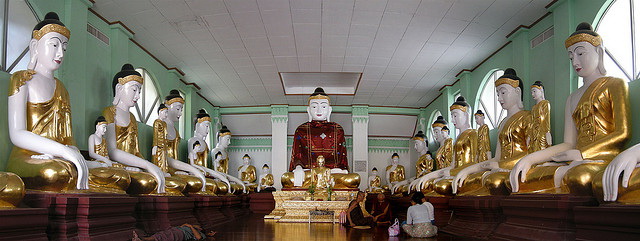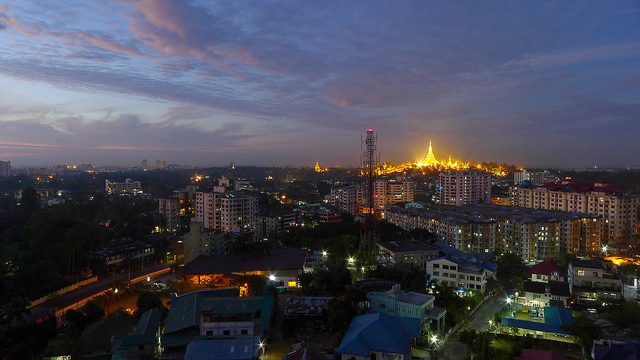
|
Shwedagon Pagoda
However, no official documents attesting its construction exist and its age is still a matter of debate.
There is little wonder that the Shwedagon is referred to in Myanmar as "The crown of Burma." As Myanmar's most revered shrine it has always been customary for families, mendicants and followers of the Buddha to make the pilgrimage to the Shwedagon in much the same way that Muslims feel compelled to visit the Kaaba at Mecca at least once in their lifetime. Such is the potency of the Shwedagon that Myanmars generally hold it to be indestructible. Despite a major earthquake in 1769, several smaller quakes in the 20th century and a major fire in 1931, it still stands imposingly on the top of a hill. Visitors are required to remove their shoes upon entering the Shwedagon and negotiating the scalding floor tiles between the shaded sanctuaries is not an easy process. The pagoda is said to contain eight hairs of the Buddha, a fact that only adds to its prestige. The stairways and bridges leading into the main sanctuary serve the thousands of pilgrims who flock here, and flower and book stalls, peddlers of religious souvenirs and tea shops do a brisk trade during the Shwedagon's long hours of opening.
"The Shwe Dagon," wrote Somerset Maugham in 1930, "rose superb, glistening with gold, like a sudden hope in the dark night of the soul."
|
|
|
| © TheShwedagonPagoda.com - All Rights Reserved - Privacy Policy |
 The main gold-plated dome is topped by a stupa containing over 7,000 diamonds, rubies, topaz and
sapphires, the whole giddy concoction offset by a massive emerald positioned to reflect the last rays of the
setting sun.
The main gold-plated dome is topped by a stupa containing over 7,000 diamonds, rubies, topaz and
sapphires, the whole giddy concoction offset by a massive emerald positioned to reflect the last rays of the
setting sun.
 Travelers will see temples everywhere they go in Myanmar, and will doubtless be struck by the
wealth and profusion of building styles. At Pagan for example, there is an ancient plain containing over 2,000
temples and pagodas, surely one of the most remarkable ensembles in the world. Yet still, assessed on their
individual merits, the Shwedagon Pagoda remains unrivaled as temple, meeting place and symbol of national
identity.
Travelers will see temples everywhere they go in Myanmar, and will doubtless be struck by the
wealth and profusion of building styles. At Pagan for example, there is an ancient plain containing over 2,000
temples and pagodas, surely one of the most remarkable ensembles in the world. Yet still, assessed on their
individual merits, the Shwedagon Pagoda remains unrivaled as temple, meeting place and symbol of national
identity.